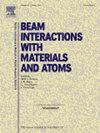Effect of thermal neutron irradiation on CoLaxFe2-xO4 nanoferrites: XRD, FTIR, UV, and VSM spectroscopy
IF 1.4
3区 物理与天体物理
Q3 INSTRUMENTS & INSTRUMENTATION
Nuclear Instruments & Methods in Physics Research Section B-beam Interactions With Materials and Atoms
Pub Date : 2025-02-01
DOI:10.1016/j.nimb.2024.165592
引用次数: 0
Abstract
Cobalt-lanthanum ferrite nanoparticles with the formula CoLaxFe2-xO4 (x = 0.0 and 0.06) were prepared using the co-precipitation method. The structural and physical properties were studied before and after exposure to thermal neutrons. The samples were irradiated at different times and doses using a rabbit system. X-ray powder diffraction (XRD) analysis showed the formation of the cubic spinel phase both before and after irradiation. The cation distribution for all samples was calculated based on the theoretical lattice parameters before and after irradiation. The FTIR spectra revealed two bands, νT (580–571 cm−1 for x = 0, and 585–575 cm−1 for x = 0.06) and νO (386–359 cm−1 for x = 0, and 383–376 cm−1 for x = 0.06). These bands became broader after irradiation. UV spectroscopy indicated that the increase in energy gap is mainly due to the decrease in particle size caused by the quantum confinement size effect. Vibrating Sample Magnetometer (VSM) measurements at room temperature showed ferrimagnetic behavior for all samples. It was observed that the magnetic properties depended on the radiation dosage.
热中子辐照对CoLaxFe2-xO4纳米铁氧体的影响:XRD, FTIR, UV和VSM光谱
采用共沉淀法制备了配方为CoLaxFe2-xO4 (x = 0.0和0.06)的钴镧铁氧体纳米颗粒。研究了热中子辐照前后材料的结构和物理性质。使用兔系统对样品进行不同时间和剂量的辐照。x射线粉末衍射(XRD)分析表明,辐照前后均形成立方尖晶石相。根据理论晶格参数计算辐照前后各样品的阳离子分布。FTIR光谱显示出两个波段,νT (x = 0时580 ~ 571 cm−1,x = 0.06时585 ~ 575 cm−1)和νO (x = 0时386 ~ 359 cm−1,x = 0.06时383 ~ 376 cm−1)。辐照后这些条带变宽。紫外光谱分析表明,能隙的增大主要是由于量子限制尺寸效应导致粒子尺寸减小所致。振动样品磁强计(VSM)在室温下的测量结果表明,所有样品都具有铁磁行为。观察到磁性能与辐照剂量有关。
本文章由计算机程序翻译,如有差异,请以英文原文为准。
求助全文
约1分钟内获得全文
求助全文
来源期刊
CiteScore
2.80
自引率
7.70%
发文量
231
审稿时长
1.9 months
期刊介绍:
Section B of Nuclear Instruments and Methods in Physics Research covers all aspects of the interaction of energetic beams with atoms, molecules and aggregate forms of matter. This includes ion beam analysis and ion beam modification of materials as well as basic data of importance for these studies. Topics of general interest include: atomic collisions in solids, particle channelling, all aspects of collision cascades, the modification of materials by energetic beams, ion implantation, irradiation - induced changes in materials, the physics and chemistry of beam interactions and the analysis of materials by all forms of energetic radiation. Modification by ion, laser and electron beams for the study of electronic materials, metals, ceramics, insulators, polymers and other important and new materials systems are included. Related studies, such as the application of ion beam analysis to biological, archaeological and geological samples as well as applications to solve problems in planetary science are also welcome. Energetic beams of interest include atomic and molecular ions, neutrons, positrons and muons, plasmas directed at surfaces, electron and photon beams, including laser treated surfaces and studies of solids by photon radiation from rotating anodes, synchrotrons, etc. In addition, the interaction between various forms of radiation and radiation-induced deposition processes are relevant.

 求助内容:
求助内容: 应助结果提醒方式:
应助结果提醒方式:


